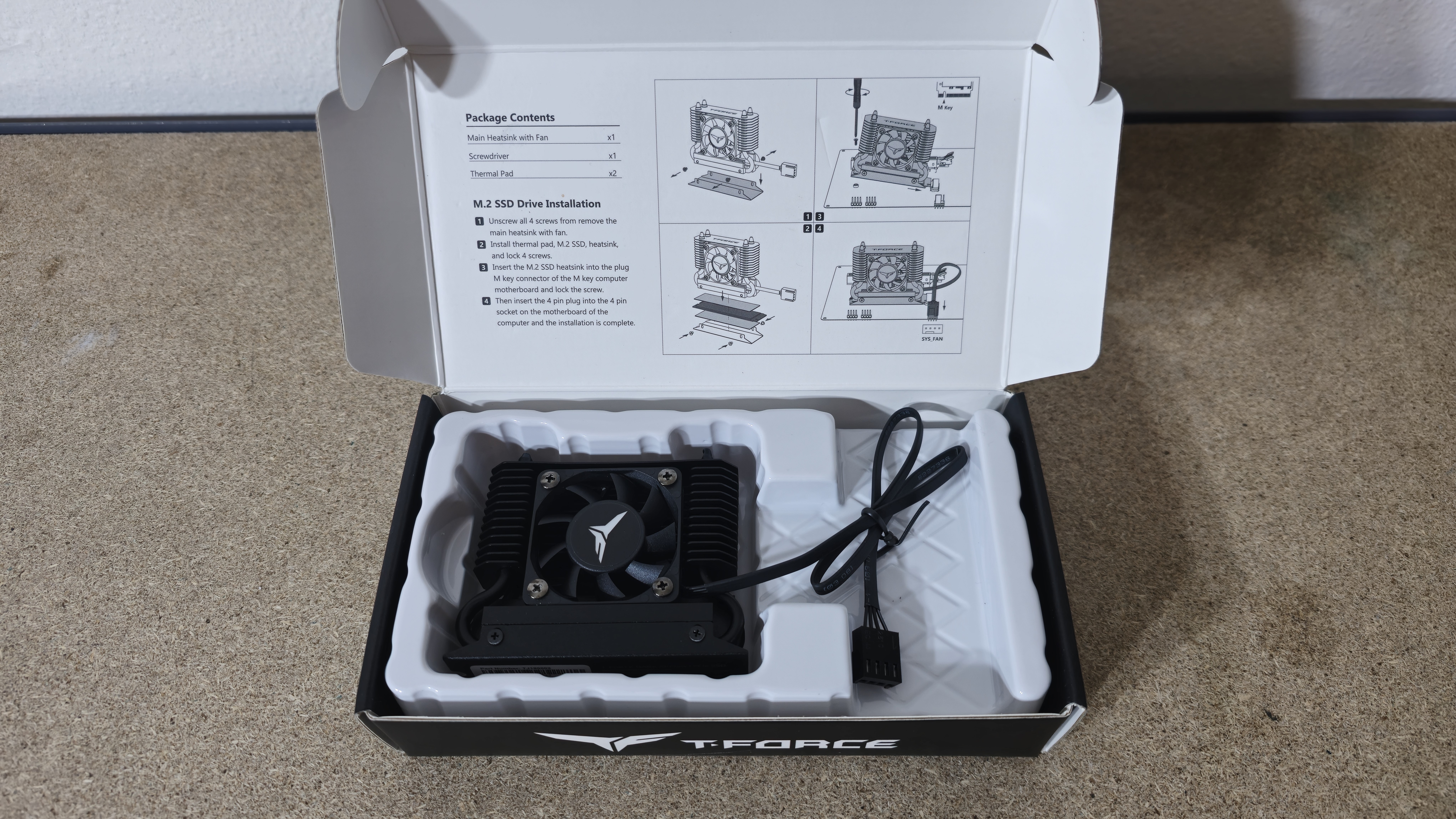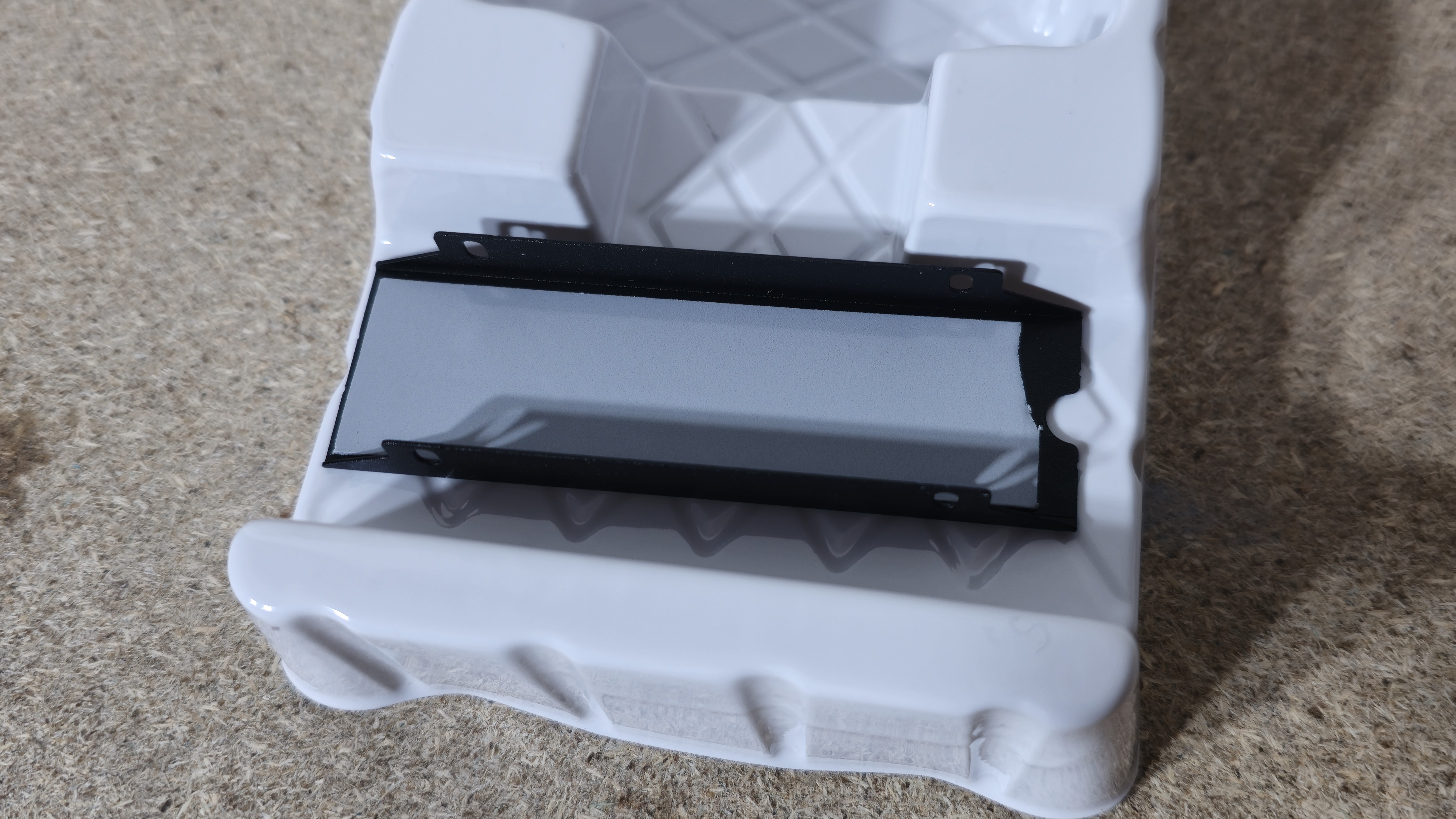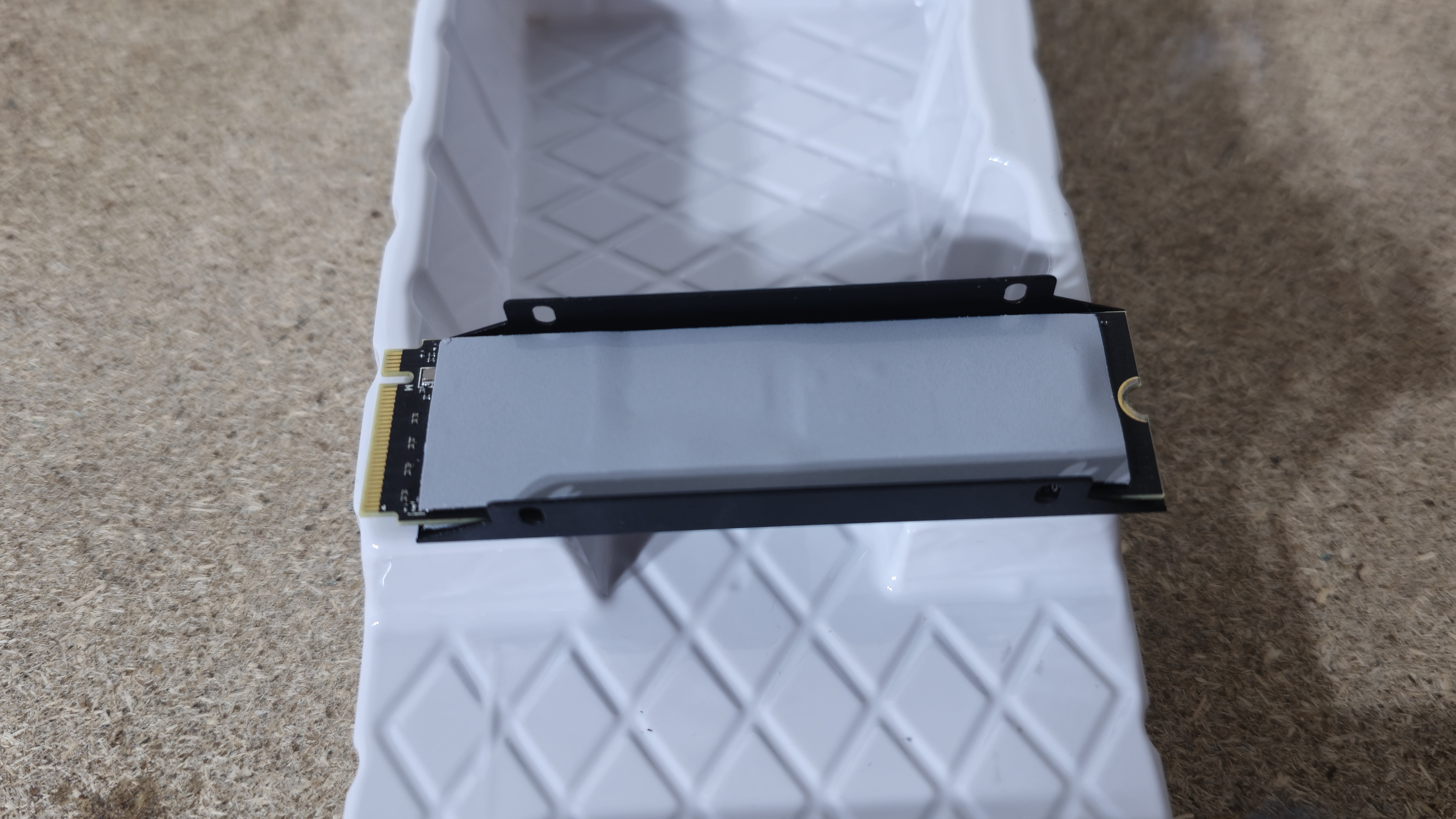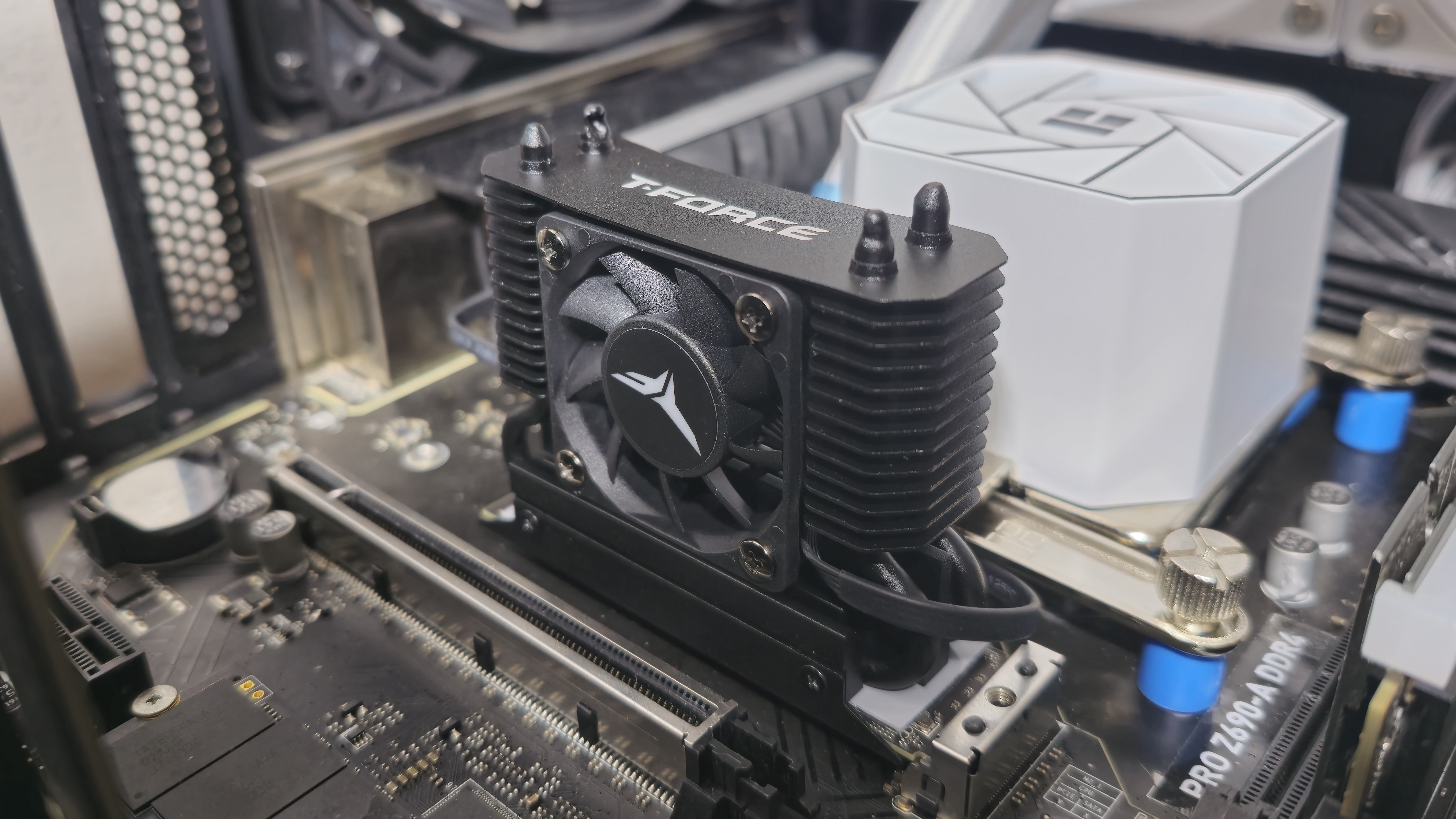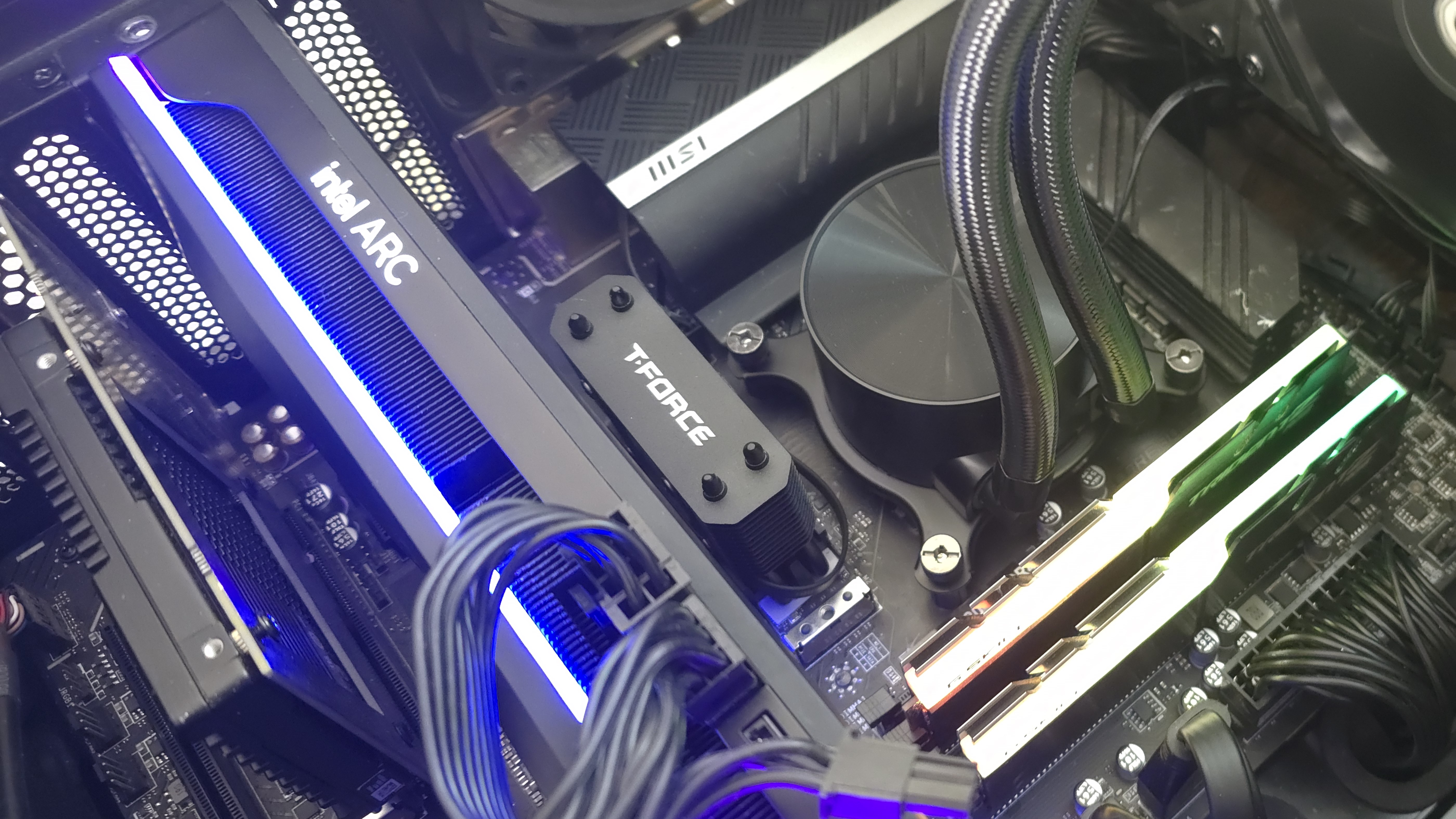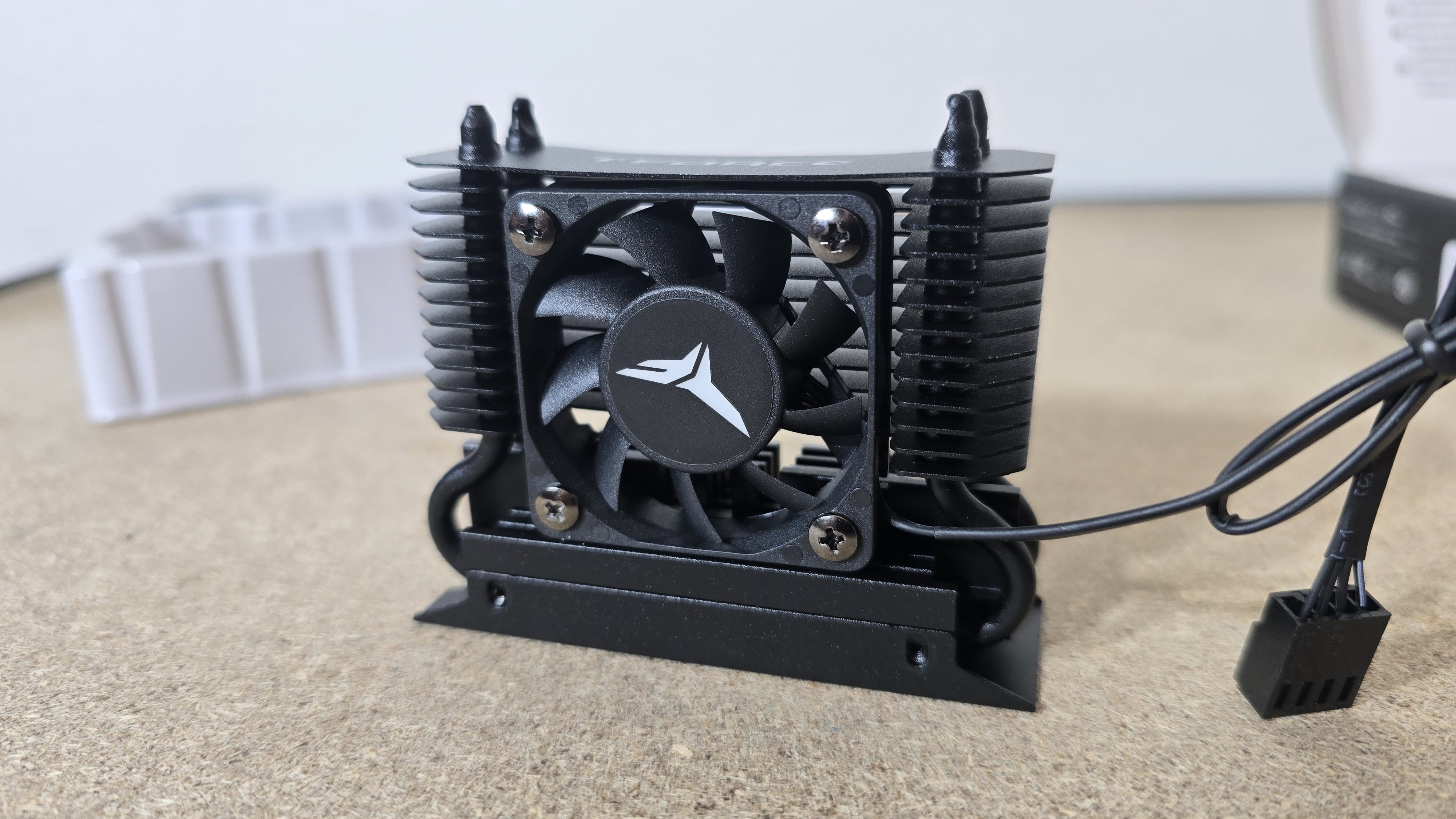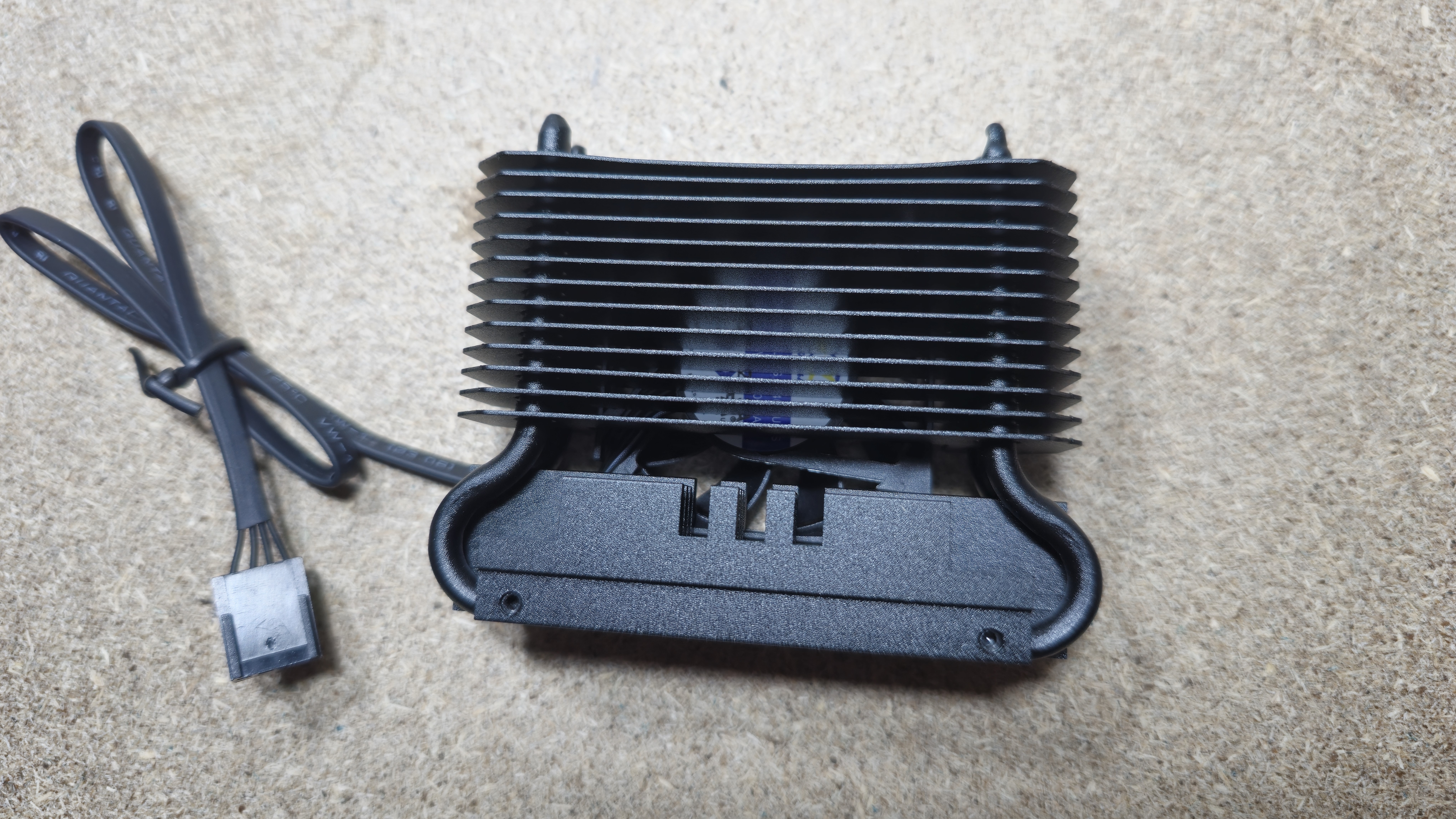Tom's Hardware Verdict
TeamGroup’s T-Force Dark Airflow I provides excellent cooling for your SSD, even if you don’t use the included fan.
Pros
- +
Strongest thermal performance of any heatsink I’ve tested
- +
Pitch black aesthetic
- +
Performs well even without the included fan
Cons
- -
Tall height may interfere with some air coolers
- -
Loud maximum noise levels
Why you can trust Tom's Hardware
Until recently, cooling and storage was at best an afterthought for most enthusiasts and PC builders – it really wasn’t a concern outside of servers jam-packed full of hard drives.
But current-generation PCIe 5 SSDs can transfer more data than ever before, and pushing those speeds can generate a fair bit of extra heat. With these modern drives, not only is some kind of cooling recommended, but it’s a requirement to prevent throttling or even crashing in some instances.
Over the past couple of years, manufacturers have begun creating a wide variety of heatsinks and coolers for NVMe SSDs to ensure that they can maintain their maximum speeds. Heatsinks large and small, with or without active fans, and even liquid cooling solutions are now available for NVMe SSDs.
TeamGroup’s T-Force Dark AirFlow I is the latest M.2 NVMe SSD heatsink cooler to land in our test bed. It features a pitch-black design, a mini tower of fins with two copper heatpipes, and an active 40 mm fan for enhanced heat dissipation. Does it perform well enough to compete with the best SSD heatsinks for your storage? Before we get to the benchmarks, we’ll take a quick look at the features and specifications of the cooler.
Cooler specifications
| Heatsink | TeamGroup T-Force Dark Airflow I |
| MSRP | $34.99 |
| Heatsink Material | Multilayered Aluminum Alloy |
| Compatibility | M.2 2280 |
| Dimensions | 105 mm (L) x 55.5 mm (W) x 11 mm (D) |
| Weight | 83 grams |
| Warranty | 1 year |
Packing and included contents
The Dark Airflow I arrives in a box similar in size to my Samsung S24 Ultra smartphone, but deeper. Opening the box reveals the heatsink in plastic packaging.
You’ll find instructions on how to install the device printed on the inside of the box. Underneath the plastic packaging are thermal pads and a small screwdriver.
Installation
The installation of the NVMe heatsink is fairly simple.
Get Tom's Hardware's best news and in-depth reviews, straight to your inbox.
1. To begin, you’ll first need to disassemble the unit. Then, you’ll take the base of the heatsink and apply the first thermal pad to it.
2. Place your M.2 NVMe SSD onto the thermal pad. Take the second thermal pad, and place it on top.
3. Next, place the heatsink on top of the SSD and secure it using the included screws.
4. The last step is to place the unit into an M.2 slot and secure it using a screw or motherboard latch, and connect the PWM connection to a motherboard header.
Features of Teamgroup’s T-Force Dark Airflow I
▶ Compatible with most GPUs
Despite its larger size, TeamGroup’s Airflow I can be installed next to most GPUs on the market without compatibility problems. However, if you have one of the RTX 4090 GPUs that covers the NVMe slot next to your CPU, you’ll have to use an alternative slot.
▶ Double-sided SSD cooling support
Some NVMe heatsinks only effectively cool the top side of an SSD – which means they’re not effective for drives with NAND on both sides of the PCB. This is especially a problem with the standard heatsinks used for most motherboards and will result in throttling if the NAND on the bottom side of the SSD is stressed. The Dark Airflow I supports double-sided SSDs and will keep both sides of the unit cooled effectively, which enables maximum unthrottled performance.
▶ Tall heatsink with fins and two copper heatpipes
The Dark AirFlow I incorporates a black heatsink with multilayered aluminum alloy fins and two copper heatpipes for enhanced heat dissipation. It is quite possible that – with a little bit of modification – this unit could be adapted to effectively cool low-end CPUs.
▶ Active fan for cooling supremacy
In addition to the fins and copper heatpipes, the Dark Airflow I also utilizes a 2510-type fan for better cooling performance.
▶ Solid black aesthetic
Every part of the heatsink – including the fins, the copper heatpipes, the fan, and even the cord of the unit – are all solid black.
Testing Methodology: How hot is too hot? Does cooling even matter for a SSD?
With SSD heatsinks, many readers are likely asking if it really matters. And if you’re a typical user who merely loads a few applications and games from time to time – you probably don’t need an advanced heatsink. I’ve run a variety of tests, and for common tasks like loading a game or application, you generally don’t need more than a basic heatsink – at least not with current SSDs and workloads.
Many users who do need cooling for their drives will already be aware that they need one. This includes users whose workloads are IO-intensive or involve high-resolution video editing.
We’re also trying to look to the future here, to an extent. While today’s common workloads might not need anything more than a basic heatsink, this may change with PCIe 6 and future standards that will allow for higher speeds (and potentially higher power consumption) in consumer SSDs.
After consulting storage experts across the industry who work for Sabrent, Solidigm, Phison, Micron, and other storage manufacturers, I’ve created an IOMeter script that’s specifically designed to stress an SSD’s controller and NAND, causing it to reach its maximum temperature (also known as TJ Max). The ambient temperature is maintained at 23 degrees Celsius while these tests are performed. The SSD used is Teamgroup’s Z540, powered by Phison’s E26 controller.
This test will cause throttling when paired with lower-end heatsinks. For those heatsinks, we’ll be looking at the IOPS of the drive during testing. The more advanced heatsinks and coolers will be capable of keeping the SSD under its peak temperature – for these units, we’ll compare the actual temperatures of the TeamGroup Z540 SSD.
When I was determining how to test these units, I consulted with many storage industry experts. They emphasized that modern PCIe 5.0 drives need at least some kind of cooling to avoid throttling and that even basic workloads can be impacted by minor throttling without a heatsink.
Users with storage-intensive workloads will require a stronger heatsink, like the Teamgroup Dark Airflow I SSD heatsink we’re reviewing today, to prevent their drive’s performance from throttling. The impact of this potential throttling can vary: Lighter loads won’t be impacted as much, but in the worst-case scenario I tested, I measured a 92% loss of performance without cooling on a PCIe 5.0 SSD.
You might think that’s the only aspect to consider when looking at a heatsink, but the thermals of a SSD also have a huge impact on a drive’s longevity. Much like other electronic components, extreme variations in temperature cause wear and tear, reducing lifespan. Now, let's be real here: Most users shouldn’t need to worry about longevity, and instead should purchase a drive from a reliable manufacturer that has a good warranty. While this is our general recommendation, there are scenarios where this won’t apply. If you purchased a refurbished SSD at a discount, you can’t expect to have a long warranty.
Finally, there’s the matter of dealing with the hassle of a warranty. While it is nice to know that a failing drive will be replaced by the manufacturer, why create an environment where such a claim is likely to happen? I’d argue that it would be wiser to invest $10 or $15 into a heatsink to extend the lifespan of your SSD so that you don’t have to worry about dealing with the paperwork and time involved to process a warranty claim.
In theory, if your NVMe SSD arrives with a heatsink from the manufacturer, you shouldn’t need to worry about a heatsink at all. Most of the heatsinks I’ve seen paired with high-end PCIe 5 SSDs are more than capable of handling strong thermal loads. However, many drives do not include a heatsink in the box, and it would be a bad ideal to run a high-speed PCIe 5 SSD entirely uncooled, as performance will suffer even in common workloads.
When it comes to heatsinks for SSDs, the important thing to take away here is that every expert I’ve spoken to in the storage industry agrees that it is best practice to minimize temperature variations for the health and longevity of your SSD. How strong of a heatsink you’ll need is another matter for debate. In common scenarios, most users will be fine with basic heatsinks.But professionals or users with storage-intensive workloads might want to invest in a stronger heatsink.
Testing configuration – Intel LGA1700 platform
To test the heatsinks, I’ve created a custom IOMeter script with input from experts in the industry. I run an initial test of 30 minutes after installing the heatsink to burn it in. After turning the system off and allowing it to fully cool down, I run another 30-minute test. I’ll repeat the process for verification and if there is no variance I consider the results accurate. If there is variance, I’ll test the heatsink twice more.
Tests are performed inside of a real case, BeQuiet’s Silent Base 802. I use a 360mm AIO to avoid having the CPU Cooler potentially impact the results, but there’s an argument to be made that the most petite heatsinks should be tested under an air cooler. We’ll investigate this further in upcoming reviews to see how much – or little – this can impact the results of lower-end heatsinks.

Albert Thomas is a contributor for Tom’s Hardware, primarily covering CPU cooling reviews.
-
bit_user Reply
I would love to have such a capable cooler for the SoC in my mini PC. My, what crazy times we live in!Albert Thomas said:This could cool a low-end CPU!
: )
Did you find any way of checking to see how well the bottom side of the SSD was cooled? FWIW, it seems to be only partially-populated:The article said:The Dark Airflow I supports double-sided SSDs and will keep both sides of the unit cooled effectively, which enables maximum unthrottled performance.
I always thought the best way to use these double-sided coolers would be to put some thermal compound in between where the top & bottom parts of the cooler overlap. That way, you might get more effective transfer of heat from the bottom to the top. If there were a way to measure the temperature of the bottom NAND chips, this hypothesis could be tested. -
dmitche31958 I always loving the Pros and Cons. "Pitch black aesthetic". I view this as a con and I would prefer Pitch white myself. Why are simple personal choices that have no baring on a product considered Pros and Cons? Really.Reply -
bit_user Reply
Yeah, it seems like such subjective points really should be listed under a separate category, like Other Points of Interest.dmitche31958 said:I always loving the Pros and Cons. "Pitch black aesthetic". I view this as a con and I would prefer Pitch white myself. Why are simple personal choices that have no baring on a product considered Pros and Cons? Really. -
Notton In my experience, cooling the underside of an SSD is all about slapping on the thickest thermal pad that the mobo allows. The top side cooler does a decent job of sucking away the heat, if it's large enough.Reply
If you need replacement heatsinks for a N100, like I did, definitely look at old northbridge/VGA coolers, 1U server CPU heatsinks, and mosfet heatsinks.bit_user said:I would love to have such a capable cooler for the SoC in my mini PC. My, what crazy times we live in!
If the heatsink mounting holes are non-standard length, you can use a slotted flat metal repair bracket, some washers, and longer screws (usually M2 or M3) to mount it.
I had an old Thermalright HR-05 with most of the hardware needed for completely passive cooling. -
bit_user Reply
Thermal pads are far less heat-conductive than aluminum or copper, so you'd rather have one that's thin and devote excess room to a thicker backplate. If someone were serious about M.2 backside cooling, I'd expect the bottom part should be made of copper.Notton said:In my experience, cooling the underside of an SSD is all about slapping on the thickest thermal pad that the mobo allows.
Thanks for the advice, but being BGA the boards each tend to have custom-spaced mounting holes. My SoC is the N97, which has higher power & frequency limits. I can get CPU + GPU workloads to push package power up to 18 W (software-reported). At that point, system power is mysteriously 48 W, though I'm not sure where the other 30 W goes. You can feel everything else on the board and the CPU is far-and-away the hottest thing. Even the VRM isn't very hot.Notton said:If you need replacement heatsinks for a N100, like I did, definitely look at old northbridge/VGA coolers, 1U server CPU heatsinks, and mosfet heatsinks.
Not sure what you mean by "length". Can you give an example of "slotted flat metal repair bracket"? Not sure if it would help me.Notton said:If the heatsink mounting holes are non-standard length, you can use a slotted flat metal repair bracket, -
Notton Reply
This stuff is usually used for wood furniture repair, but can also be used to clamp down a heatsink.bit_user said:Not sure what you mean by "length". Can you give an example of "slotted flat metal repair bracket"? Not sure if it would help me.
caveat: the heatsink needs to have a flat top
https://www.amazon.com/dp/B09XX22BSF -
PEnns The SSD coolers are getting ever bigger by the day.Reply
At this rate, the inside of a PC would look like a Manhattan silhouette!
-
dwd999 For those of us who obsess about such things, it would be interesting to try one of these with a Noctua NF-A4x10 or NF-A4x20 PWM fan to see if its quieter. Although those fans do not come in black.Reply -
Albert.Thomas Reply
I don't have a way of separately measuring the temperature of the bottom NAND, but if the bottom isn't cooled properly throttling is observed in my tests.bit_user said:Did you find any way of checking to see how well the bottom side of the SSD was cooled? FWIW, it seems to be only partially-populated:
-
Amdlova I got a 22110 here with some thermal pads on bottom of ssd you can make the motherboard grab some heat. But will be a limit over time before the ssd hit the limit wall.Reply
Put an old am3 atlhon fan 70x70mm at lowest rpm (650 rpm) just to maintain the temperature of the components

